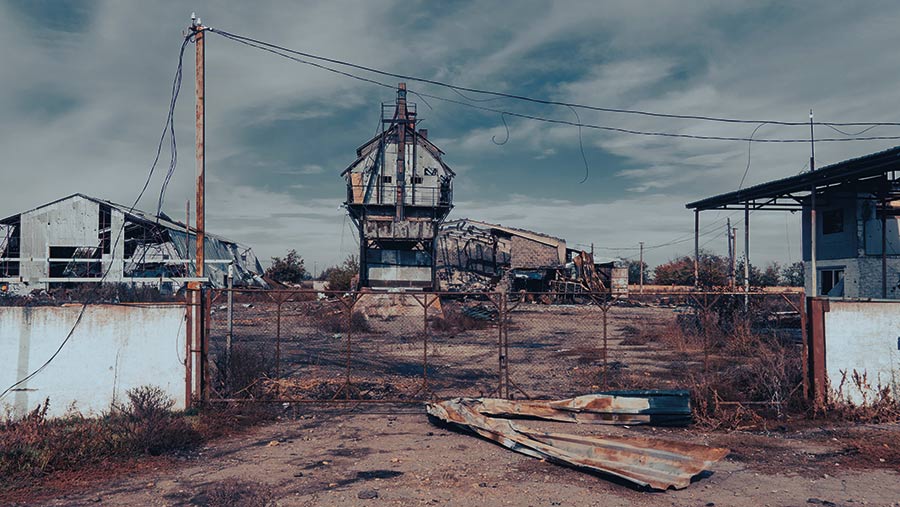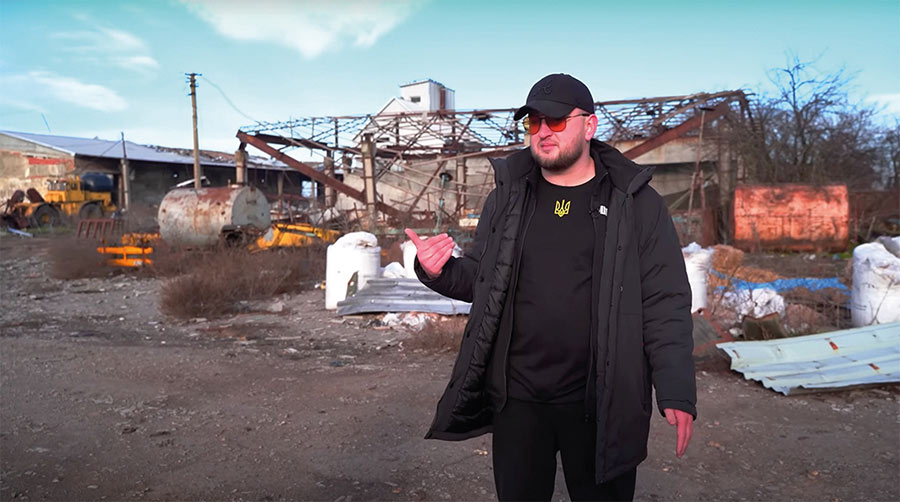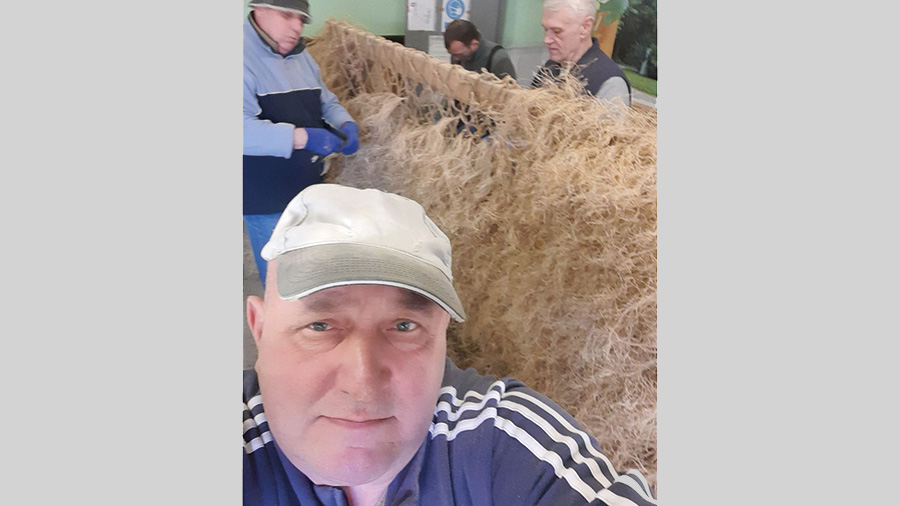Ukraine War: The impact on agriculture one year on
 © Oleksandr Baranov/Adobe Stock
© Oleksandr Baranov/Adobe Stock One year has passed since Russia launched a full-scale, illegal invasion of Ukraine on 24 February 2022. The conflict grinds on, with no end in sight.
The Kyiv School of Economics (KSE) Agrocenter estimates that, during the first eight months of war, direct losses to Ukrainian agribusiness from Russian aggression came to $6.6bn (£5.45bn), or 23% of the total value of Ukraine’s farming assets.
And it puts the total amount of indirect losses inflicted on Ukraine’s agricultural industry at about $40bn (£33bn) for 2022.
See also: Ukrainian farms battle for survival and global food security
Farm machinery has suffered the most damage, according to the KSE Agrocenter. It estimates 82,400 pieces of kit have been totally or partially damaged, with replacement costs reaching $2.9bn (£2.39bn).
Meanwhile, storage facilities for grain, food and agricultural products have suffered $3bn (£2.48bn) of damage.
And about 2.8m tonnes of grain and 1.2m tonnes of oilseeds have been destroyed or stolen by occupying Russian forces.
Ukrainian livestock farmers have lost 95,000 sheep and goats, 212,000 cattle, 507,000 pigs and almost 11.7 million poultry birds, either by being bombed, shot or killed by disease or starvation.
Oleg Nivievskyi, an assistant professor at KSE who specialises in agricultural economics, says government and industry data show Ukraine’s expected crop output for this year is back to 2012 levels.
Ukrainian farming enterprises are also struggling with liquidity challenges.
“Basically, the prices are too low because logistics costs are too high,” he says. “Farmers can barely make a profit and the majority declare losses.”
A lack of access to financing in the private sector in wartime Ukraine, due to prohibitively high borrowing rates domestically and internationally, is compounding problems.
More than 5m ha of Ukraine’s farmland has been damaged in the war, Prof Nivievskyi says. Vast areas will need de-mining and recultivating.
Major rebuild
Even if the war stopped today, Prof Nivievskyi believes Ukraine would need 10 years to rebuild its agricultural industry.
The absence of a long-term recovery plan is also concerning, he says. The availability of skilled farmworkers was scarce before the war, but is worse now, he adds.
The Ukrainian Agri Council says Ukrainian farmers, especially in the occupied territories, have suffered a year of hell since Russian soldiers invaded. Some farms have been destroyed by bombs and artillery.
Over the past year, farmers in the occupied territories have lost millions of tonnes of crops after the occupiers looted grain stores, robbed farms and exported grain to Russia.
Many have also seen their machinery and equipment stolen, which has stymied their efforts to prepare fields and sow crops.
Andriy Dykun, a farmer and head of the Ukrainian Agri Council, says the occupiers are forcing Ukrainian farmers to register their farms under Russian law, obtain Russian citizenship, pay taxes to the Russian budget and report to collaborators.
Those who refuse are threatened with physical violence and the destruction of their farms, he adds.
“Farmers in the occupied territories cannot work properly, they lack spare parts, seeds, and fertilisers,” says Mr Dykun.
“Logistics chains are broken, and it is almost impossible to sell the harvest. There are checkpoints on the roads, constant searches, and threats.
“The conditions in which Ukrainian farmers are now living are terrible.”
Spring plantings
Ukrainian farmers are preparing for this year’s spring sowing campaign, which usually begins in late February or March. The main spring crops of maize, sunflowers and soya beans are drilled in April and May.
But this year’s campaign will be heavily disrupted by fields riddled with unexploded shells and mines.
Farmland covers about 70% of Ukraine’s territory and its government estimates about one-third of fields remain unfit for planting.
Consequently, Ukraine’s Ministry of Agrarian Policy has predicted a drop in spring planting of at least 20% compared to 2021.
The situation is most critical in east and south Ukraine, especially in de-occupied territories such as Kharkiv, Kherson and Mykolaiv, where retreating Russians have left farm fields completely mined, and destroyed farm equipment and buildings.
Oleksandr Sazonov, owner of the farm Agroservice Ltd, based in Volokhiv Yar village, Kharkiv province, said in late January: “We are in a hopeless situation, we have 3,000ha mined. This is half of our land.
“We filed an application for de-mining two months ago, but we still have no deadlines for the start of work.”
Fields are dangerous to work in and there are frequent reports of farmers being blown up driving tractors over mines.
Mr Dykun is concerned about the impact that a significant drop in spring plantings could have on global food security, as 400 million people, especially in African countries, rely on Ukrainian food supplies.
Active hostilities are now taking place in the regions where most of the wheat is grown – Kharkiv, Odesa and Zaporizhzhia. Taken together, this will lead to a decrease in crop yields, harvest and grain exports.
Agri-food exports
Many farmers have been forced to export their products through the western border and EU ports. Delivery to them is carried out by road and rail, which creates additional costs.
EU countries are reporting a significant increase in grain imports from Ukraine – 2.85m tonnes in 2022 compared with 287,000t in 2021.
The Ukrainian Agri Council has urged EU leaders to preserve and indefinitely extend Ukraine’s preferential trade regime with the EU, describing it as a “lifeline” for its farmers.
The UN and Turkey have brokered a deal with Russia and Ukraine for a grain corridor to allow limited exports of Ukrainian grain through the Black Sea.
In January, Ukraine shipped 5.5m tonnes of grains, oilseeds and their products – 1.3m tonnes less than in December 2022.
Ukraine’s government blamed this downward trend on artificial blocking of the grain corridor by Russian inspectors, which Moscow has denied.
The Black Sea Grain Initiative is set to expire in mid-March and Ukrainian farmers do not know whether or for how long it will be extended.
Andrey Sizov, head of SovEcon, a market analysis firm focused on the Black Sea agricultural region, says based on recent experience, it is likely that the grain deal will be extended.
“The grain deal was almost silently resigned in early November, despite several dozen statements from Russian top officials, including Putin, complaining about sanctions against Russian food and fertilisers,” he says.
“We believe that Turkey’s president Erdogan is likely to have a final say on the grain deal extension. He was a big supporter of it in the past and still is.
“President Erdogan is facing a challenging election shortly and the grain deal is an important political topic for him.
“Since the start of the war, Russia has become dependent on Turkey amid Moscow’s growing international isolation.
“Taking all this into account, I think there is a good chance the deal will be extended again.”
Mr Sizov says reports of a big renewed Russian offensive this spring may be over-played.
“It’s kind of more gradual. They are sending more troops, but it’s not just a one-time event.”
He believes the short-term impact on grain shipments out of Russia and Odesa terminals in Ukraine “will be negligible, if any”.
Currently, he reports Russian grain is being sold either close to, or at, record high prices.
However, Mr Sizov says a Russian naval drone attack on 10 February on Zatoka Bridge, near Odesa, a strategic bridge connecting Ukrainian grain exports to Romania/Moldova, could have more serious implications.
So will the ongoing problems Ukrainian farmers face in terms of getting on the land to prepare fields and sow crops this spring.
Case studies
Farmer scarred for life after Russian sniper attack
Farmer Andriy Povod has a permanent reminder of how Russian troops “liberated” Kherson region – bullet scars on his neck and arm.

© SAVE UA charity
Andriy’s father owns the agricultural enterprise called “UKAN”, which is located near Bilozerka, Kherson province, in southern Ukraine. He works there as a deputy director.
Russian troops seized the farm at the start of the conflict and made it their base of operations.
Andriy and his father decided to visit the farm in early March. En route, Russian snipers suddenly opened fire on their car and Andriy was hit twice.
Bleeding from his neck and arm, he spun the vehicle around and drove off at full pelt.
Andriy still keeps the car, which resembles a sieve, in his garage, as a reminder he is lucky to be alive.
The company and its owner lived under occupation for nine months. After the fierce battles for the liberation of the Kherson region, the farm was flattened.
The Russians also stole grain and equipment.
Andriy, who is a member of the Ukrainian Agri Council, said: “Everything my dad had been building for 20 years of his life has ceased to exist with the beginning of Russia’s futile war against Ukraine.”
‘We will return and restore everything’, vows farmer
Igor Mystuk was living and working as a farmer in Zaporizhzhia province when invading Russian troops entered his village late last February.
The farm is in Balochki, Pologiv district, and has been run by his father since 1997. They grow sunflowers, wheat and peas. Igor worked for the police before joining his father’s farm in 2012.
At the start of the war, the farm was operating successfully across 700ha. Funds were mainly invested in cultivation equipment and five workers were employed.
On 20 March 2022, Igor, 32, his wife, their five-month-old daughter and his parents left the village. His family currently lives in Lviv region, while his parents live in Zaporizhzhia province.
Their business partners remain in the village. Last autumn, they harvested the wheat, but the Russians removed all 300-400t of it. They have also stolen all the equipment. There is almost nothing left.
Igor now lives in the Sambir district of Lviv and helps an agro-entrepreneur from Ireland. They grow maize, winter and spring wheat, barley, oats and soya beans.
Asked if he wants to return to his farm after war ends, Igor says: “I believe victory will be ours. Of course, we will return, we will restore and revive everything.”
Russian troops occupy berry grower’s farm and outbuildings
Oleksiy Savin grows raspberries and blackberries on a small private farm with 6ha of land in the Kherson region, where he employs up to 100 workers during harvest.

© Ukrainian PR Army
He has developed his own techniques for growing the berries, and anticipates producing 75t this season for local markets in Kherson, Mykolaiv, Odesa and Mariupol.
Before the war, Oleksiy used to send 1,000kg of fresh berries to Mariupol daily during peak season.
However, the city in southern Ukraine has been destroyed by Russian airstrikes and is now under occupation by its forces.
In the first week after the invasion, he and his family remained at home as bombs and rockets were exploding on both sides of Antonovsky Bridge, in Kherson.
But they have had to relocate several times, before finally settling in Kamenets-Podolsko, a city in the west.
Oleksiy says he, like many farmers, was deprived of a harvest last year and is borrowing more money off the bank to survive.
His farm and outbuildings have been captured by Russian soldiers. He fears that, without watering, his berry bushes will die from the heat if he is unable to return before the spring.
“Russian troops live in the house, they broke everything, they say that they took out everything from a hammer to a gas boiler,” Oleksiy says.
“But we can’t return to Kherson yet, there is constant shelling. There has been three months of non-stop heavy gunfire in the occupation, then almost four months in Zaporizhzhia with periodic rocket attacks.”
Impact for UK farmers: ‘Manage cashflow and take long-term view’, says AHDB
The lasting impacts of high inflation partly driven by the Ukraine war will keep pressure on UK farm businesses during 2023, predicts David Eudall, the AHDB’s director of economics and analysis.
Events in 2022 generated high prices, which led to increased margins in some sectors, but created high costs in others.
This year will see many farm businesses face continuing challenges, Mr Eudall says.
Although energy markets have relaxed somewhat in recent weeks, it will take time for the inflationary effects of the past 12 months to pass through supply chains.
“These high costs are being met with almost zero growth in the economy, which is creating sluggish demand as consumers watch their spend,” Mr Eudall says.
“So, our farming industry faces a year in which costs remain high, but demand, and so prices – such as we’re seeing in the dairy market – start to dip.”
Many farmers focus on the current season.
But longer-term planning is crucial, he stresses, especially as direct payments are now seeing significant drops and replacement subsidy schemes remain under scrutiny in their value to all farms.
Mr Eudall urges all farmers to look at their cashflow and margins over more than just one year.
“Multi-year planning smooths the inherent volatility of agricultural markets, and that’s here to stay,” he says.
